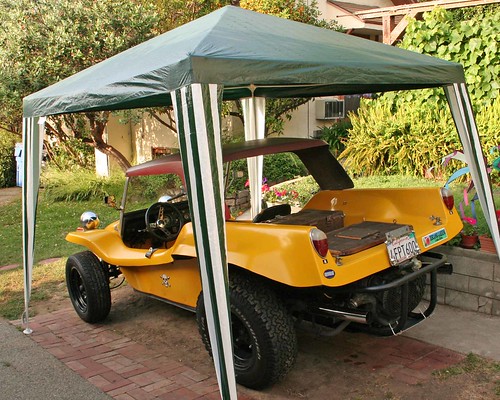
One of the worst disasters that occurred during the build happened on the day I thought I was ready to put some gas in the tank and attempt to start the car. I had carefully hooked up the rubber hoses up to either end of the steel line that runs through the tunnel down the center of the vehicle. I had even put in an in-line fuel filter so that any residual crud that had built up in the steel line would be caught before it got to the engine.
I had siphoned a gallon of gas out of one of my other cars into a plastic gas can I had acquired. I attached the pour spout and upended the can into the tank. Suddenly there was gasoline everywhere -- inside the pan, on the floor, running down the driveway -- everywhere except in the fuel lines. The one thing I had forgotten to check was the steel fuel line hidden inside the tunnel. In the years since 1957 when it had been installed at the factory, or at the time it was shortened when the pan was cut, or both, it had become more of a sieve than a line. The gasoline was running out of the holes just as fast as I poured it in. The car was saturated with fuel. There was nothing to do at that point but leave it alone and let it dry out.
While I waited for the gasoline to evaporate, I thought about how to solve the problem. I needed a new fuel line. There's no easy way to replace the original line inside the tunnel. To do so would require cutting holes in the backbone of the frame and then re-welding the holes to restore its structural integrity. I could run a fuel line under the car, but that would expose it to whatever rocks I might drive over if I ever took it off-road. No, the easiest thing to do would be to drill one hole at the front of the pan and another at the rear and run the new line inside the car along the floor. I started rummaging through all the stuff I had in the basement to see if I could find anything that would work. There was a small roll of flexible copper tubing that I had acquired somewhere, probably something I got from my dad. I remember him hooking up a water line for a refrigerator ice maker some years ago. The copper must have been left over from that job. It was 1/8" copper tubing, pretty small inside, but a Volkswagen motor doesn't need much fuel volume to run. The copper line wasn't long enough for the whole run, but if I cut it in half and used copper to get the line though the body at the front and back and filled in the rest of the run with rubber fuel line, I could do it.
The next day after the gasoline flood had evaporated, I drilled the holes and installed the new fuel line. When I tried putting fuel in the gas tank this time, the gasoline stayed where it belonged. I ran the car that way for several years. Recently I bought a longer piece of copper tubing and replaced the pieced-together line inside the car with a contiguous piece of copper and replaced all the rubber fuel lines with new ones. It was just a precaution, though, as that cobbled-together fuel line I had made was still working just fine.



